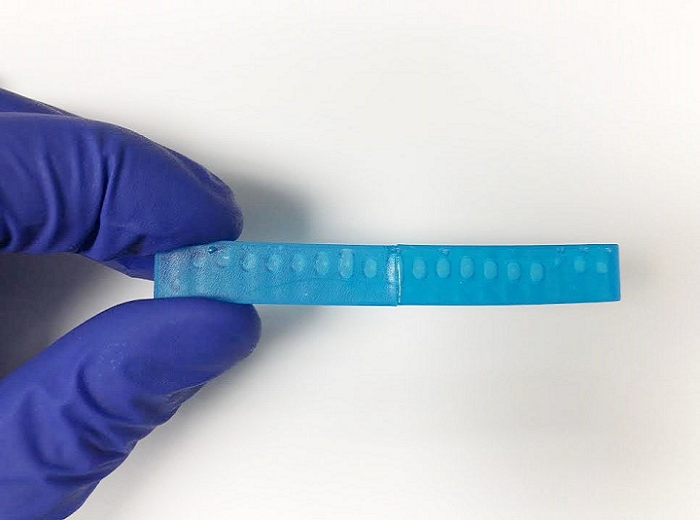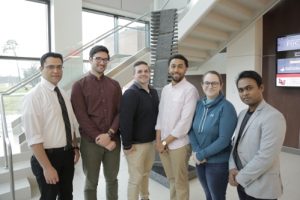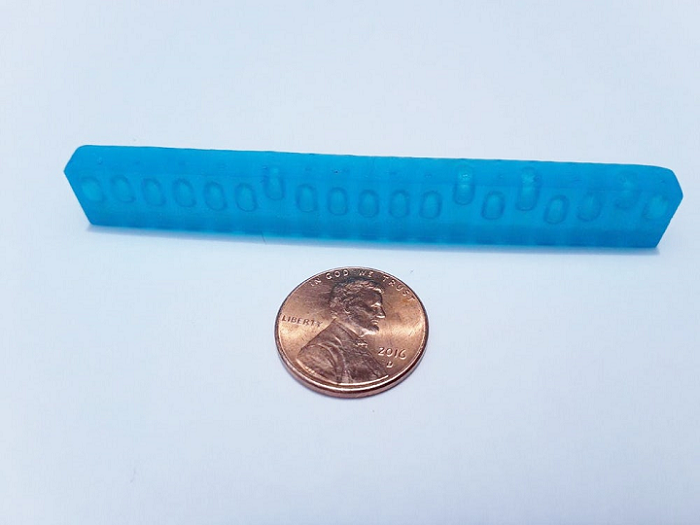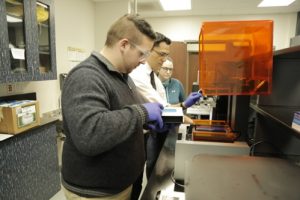Material sample with a healed break [Image: Dr. Keivan Davami]
A team of researchers from Lamar University in Texas, led by assistant professor Dr. Keivan Davami, recently developed a self-healing material using advanced SLA 3D printing technology, which has all kinds of applications, from fixing shoe soles and cell phone screens to cartilage. By exposing the material to UV light, it is capable of “autonomic self-repair,” and the researchers believe that it could help reduce how much waste is generated when a material is damaged – if it can heal itself, the damage can be repaired without any waste.
Dr. Davami, who is also the director of the university’s Nano-Micro-Macro manufacturing group, and his group published a paper on their work, titled “Additively Manufactured Self-Healing Structures with Embedded Healing Agent Reservoirs,” in Scientific Reports; co-authors are Mehrdad Mohsenizadeh, Morgan Mitcham, Praveen Damasus, Quintin Williams, and Michael Munther.
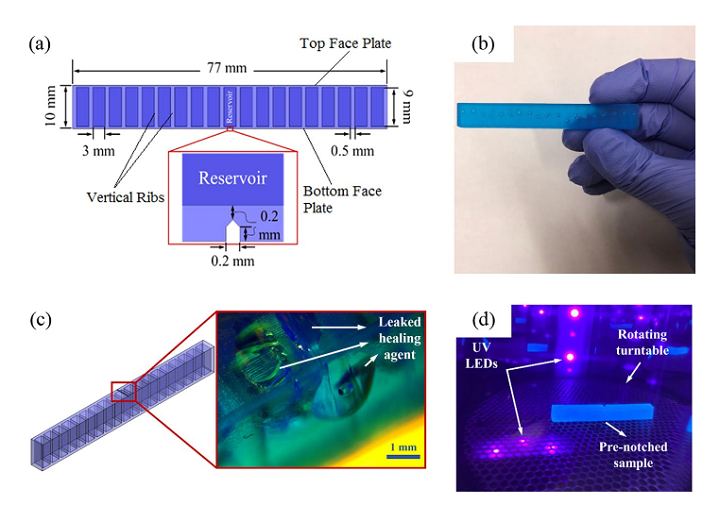
Figure 1. (a) A CAD model of the self-healing structure (front view). The inset shows the geometry of the straight notch, (b) an actual 3D printed specimen with hollow reservoirs and trapped resin, (c) a schematic of the structure with an optical image inset, showing the leaked healing agent from a crack, (d) curing the leaked UV-photocurable resin, using multi-directional UV LEDs.
The team’s material was inspired by nature – the seal-healing resin is trapped inside the material through a series of reservoirs, and it’s only released when a fracture occurs. Does this sound familiar? It’s comparable to the microvascular blood networks in our skin that, when injured, help restore our tissue. Only in this case, rather than blood coming up to an injury’s surface, capillary action allows the UV-sensitive resin to escape, so that only the necessary amount is used in order to fix isolated damage.“Self-healing materials with the ability to partially or completely restore their mechanical properties by healing the damage inflicted on them have great potential for applications where there is no or only limited access available to conduct a repair,” the researchers wrote. “Here, we demonstrate a bio-inspired new design for self-healing materials, where unit cells embedded in the structure are filled with a UV-curable resin and act as reservoirs for the self-healing agent. This design makes the repeated healing of mechanical damage possible. When a crack propagates and reaches one of these embedded reservoirs, the healing agent is released into the crack plane through the capillary action, and after polymerization through UV light exposure, bonds the crack faces. The structures here were fabricated using a stereolithography technique by a layer-by-layer deposition of the material. “Resin trapping” as a unique integration technique is developed for the first time to expand the capability of additive manufacturing technique for creating components with broader functionalities. The self-healing materials were manufactured in one step without any needs for any sequential stages, i.e. filling the reservoir with the healing agent, in contrast with the previously reported self-healing materials. Multiscale mechanical tests such as nanoindentation and three-point bending confirm the efficiency of our method.”
As a story in New Atlas explained it, “As long as those objects remain undamaged, the liquid stays contained. If the polymerized resin gets cracked, however, capillary action draws some of the liquid resin out. Once quickly exposed to an artificial UV light source, that liquid resin then polymerizes, sealing up the crack.”
[Image: Dr Keivan Davami]
According to the university, hardly any intervention other than short exposure to UV light will be necessary to repair any damage the material sustains, due to the “autonomic functionality of the self-healing mechanism.” The UV light exposure can be done remotely, which will be especially helpful when it comes to device components that are difficult to reach.
The potential benefits of this self-healing 3D printable material are far-reaching – it would be far quicker to use the material to fix everyday items that are easily damaged, like device components, eyeglasses, and tools. In addition, if more items are made with this kind of self-repairing mechanism, the amount of waste delivered to landfills due to broken products would be drastically reduced.For their paper, Dr. Davami’s research group fabricated test specimens of their material, which were designed in SOLIDWORKS, on the Formlabs Form 2 SLA 3D printer. They are now working to further develop the technology, with the goal of reducing how much light energy is required to cause the self-healing. This would mean that human intervention would not be necessary, and self-repair could occur with only ambient UV sources, like sunlight.
Discuss this story and other 3D printing topics at 3DPrintBoard.com or share your thoughts in the Facebook comments below.
Subscribe to Our Email Newsletter
Stay up-to-date on all the latest news from the 3D printing industry and receive information and offers from third party vendors.
You May Also Like
3D Printing Unpeeled: Biofuel Waste to Filament & Sustainable Photopolymers
I can’t ever remember a day with so many potentially high impact news stories have come out. In one story, we all know that there are problems with the safety...
Finnair Hires AM Craft to 3D Print Plastic Parts for Aircraft Interiors
Riga-based AM Craft, a supplier specialized in 3D printing aviation components and certified under EASA Part 21G, announced a significant achievement today. The company will assist in upgrading Finnair’s A320...
3DPOD Episode 198: High Speed Sintering with Neil Hopkinson, VP of AM at Stratasys
Neil Hopkinson, a pioneering 3D printing researcher, played a pivotal role in developing a body of research that is widely utilized today. He also invented High Speed Sintering (HSS), also...
3D Printing Webinar and Event Roundup: May 12, 2024
Webinars and events are picking up in the AM industry this week! ASTM International continues its Professional Certificate Course and Stratasys continues its advanced in-person trainings, while 3D Systems is...


